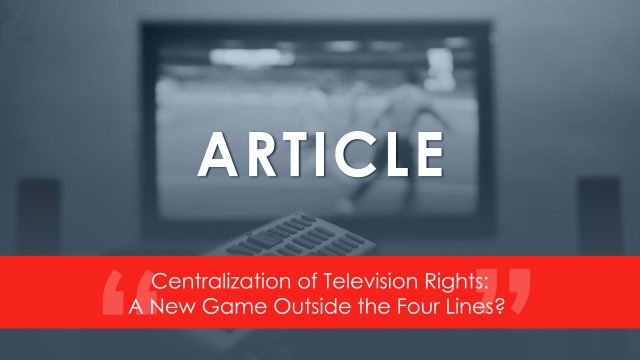
The discussion around the centralization of television rights in Portuguese football has once again gained momentum — and rightly so. The topic, which has long circulated through the corridors of Liga Portugal and club boardrooms, is now back on the table as the Government admits it may legislate if no consensus is reached among sports stakeholders.
At the heart of the matter lies the increasingly recognized need to redistribute, in a more equitable manner, the revenues derived from the broadcast of football matches, reducing financial disparities between clubs in the First and Second Leagues and strengthening the competitiveness of the national championship.
Indeed, the current model is based on individual negotiations, in which each club sells its transmission rights directly to television operators. This system naturally favors institutions with greater size and bargaining power, accentuating a financial gap that affects sporting results, competitive balance, and the sustainability of the ecosystem. Consequently, the idea of centralization emerges as a tool to correct these distortions, promising a fairer, more predictable, and more transparent market.
Nevertheless, it should be noted that implementing this model requires a complex legal and economic reconfiguration. Since 2015, Portuguese law has already provided for the possibility of centralized selling, but the lack of political consensus and resistance from some clubs have hindered its execution. Thus, the debate resurfaces in 2025, driven by the example of several European leagues that have moved in this direction with positive results, but also with significant challenges.
International Models: What Other Leagues Teach Us
By comparison, the English Premier League is often highlighted as the paradigm of successful centralization. Since 1992, rights have been negotiated collectively, with revenue distributed according to criteria that combine equality, sporting merit, and audience metrics. Around 50% of the total amount is shared equally, 25% depends on the final standings, and the remaining 25% is based on television exposure.
This balance has enabled the league to become financially robust, capable of attracting global investment and maintaining competitiveness among clubs of varying sizes.
In this case, the process originated from the initiative of the founding clubs themselves, which, upon forming the Premier League, decided to separate from the Football League and negotiate collectively with the approval of the English federation, a private model that later inspired legislation and international practices.
Spain’s La Liga, which only adopted centralization in 2015, presents a similar model, albeit still with a relevant degree of inequality. Distribution follows criteria related to audience, results, and historical relevance, while still guaranteeing a minimum equal share.
Here, the movement started with the Spanish Government, which, faced with an impasse among clubs, approved a Royal Decree-Law imposing centralized selling and requiring the league to negotiate collectively. Government intervention was decisive in unlocking the model and ensuring transparency and financial solidarity — a precedent that may inspire Portuguese lawmakers.
In Belgium, the Pro League centralized rights gradually, creating a solidarity fund that supports clubs with lower revenues and invests in infrastructure and youth development.
The Belgian model resulted from a joint initiative by clubs and the league, without direct government intervention, and was supported by a shared goal of achieving financial stability for the competition. It demonstrates that centralization can serve as a tool for strategic development, provided it is accompanied by redistribution mechanisms and effective governance structures.
In the United States, the logic differs: professional leagues (such as the NFL or NBA) operate as unified entities that own and commercialize all rights. Franchises do not negotiate individually and receive equal shares of national television revenue.
This system stems from the private and integrated structure of these leagues, not from public regulation. This extreme form of centralization ensures financial stability and competitive balance but requires a business organization that differs from the European model.
European Competitions: A Consolidated Model
It is also worth remembering that, at the European level, competitions organized by UEFA already operate under full centralization. Since 1999, UEFA has been the sole owner and manager of the commercial and broadcasting rights for the Champions League, Europa League, and, more recently, the Conference League. Revenues are pooled and later distributed to participating clubs according to criteria such as performance, historical coefficient, and national market pool.
In this case, centralization came from UEFA itself, with the approval of the European Commission, which regarded joint management as a way to protect the integrity of competitions and avoid fragmented negotiations.
In October 2025, UEFA reinforced this model by launching a new multi-market tender for the 2027–2031 cycle, aiming to increase broadcast revenues by 50%.
The process, coordinated by UC3, a joint venture between UEFA and club associations, seeks to maximize the economic value of competitions and standardize rights management globally. It is a clear example of successful centralization, though it raises debates about economic concentration and the autonomy of national federations.
What Is at Stake for Portugal
Thus, the potential centralization of television rights in Portugal is not merely a market issue; it is also a legal and institutional matter. It requires defining who will hold the power to commercialize rights — the League, the clubs, or an independent entity — and establishing criteria for revenue distribution. While the centralization of broadcasting rights may raise competition law concerns, the European Commission recognized more than twenty years ago its compatibility with European Union law, taking into account objective benefits such as efficiency gains and the equitable redistribution of revenues among clubs. Nevertheless, it remains a contentious matter.
For clubs, centralization may mean an immediate reduction in revenue for some, but greater predictability and sustainability in the medium term. It may also foster the professionalization of management, as collective negotiation requires robust governance structures and financial control mechanisms. For the public, the impact could translate into a more orderly broadcasting market, offering better access and transmission quality, though the risk of concentration among a few operators remains.
In summary, the Portuguese debate fits into a broader European trend toward consolidating sports rights, aimed at balancing competitiveness and economic sustainability. However, the political challenge of reconciling divergent interests among large and small clubs, media operators, and regulators remains. Until any change in this paradigm occurs, centralization will continue to be a sensitive topic, debated inside and outside the four lines, and all indications suggest it will remain in the spotlight in the coming months.
by Ricardo Cardoso and João Jorge Pereira, Practice Area – Sports, Fashion and Entertainment



